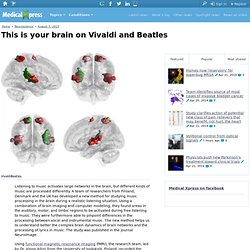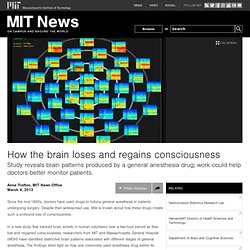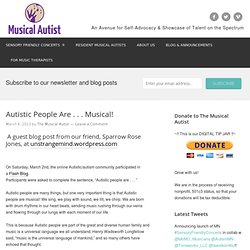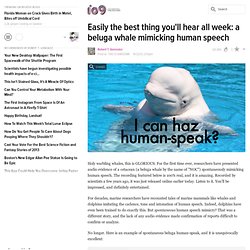

Natemacotheloch : This is both the most... The Incredible Bionic Man. This is your brain on Vivaldi and Beatles. Listening to music activates large networks in the brain, but different kinds of music are processed differently.

A team of researchers from Finland, Denmark and the UK has developed a new method for studying music processing in the brain during a realistic listening situation. Using a combination of brain imaging and computer modeling, they found areas in the auditory, motor, and limbic regions to be activated during free listening to music. They were furthermore able to pinpoint differences in the processing between vocal and instrumental music. The new method helps us to understand better the complex brain dynamics of brain networks and the processing of lyrics in music. The study was published in the journal NeuroImage. Using functional magnetic resonance imaging (fMRI), the research team, led by Dr.
Mapping and Manipulating the Brain - Download Free Content from TED. Exploring Neuroscience Through Art. Rlfrizzle : My handi- work! #brainweek... How the brain loses and regains consciousness. Since the mid-1800s, doctors have used drugs to induce general anesthesia in patients undergoing surgery.

Despite their widespread use, little is known about how these drugs create such a profound loss of consciousness. In a new study that tracked brain activity in human volunteers over a two-hour period as they lost and regained consciousness, researchers from MIT and Massachusetts General Hospital (MGH) have identified distinctive brain patterns associated with different stages of general anesthesia.
The findings shed light on how one commonly used anesthesia drug exerts its effects, and could help doctors better monitor patients during surgery and prevent rare cases of patients waking up during operations. Anesthesiologists now rely on a monitoring system that takes electroencephalogram (EEG) information and combines it into a single number between zero and 100. Lead author of the paper is Patrick Purdon, an instructor of anesthesia at MGH and Harvard Medical School.
Autistic People Are . . . Musical! A guest blog post from our friend, Sparrow Rose Jones, at unstrangemind.wordpress.com On Saturday, March 2nd, the online Autistic/autism community participated in a Flash Blog.

Participants were asked to complete the sentence, “Autistic people are . . . ” Autistic people are many things, but one very important thing is that Autistic people are musical! We sing, we play with sound, we lilt, we chirp. We are born with drum rhythms in our heart beats, sending music rushing through our veins and flowing through our lungs with each moment of our life. Listen to this young Autistic, our friend Christopher Duffley, singing Lean on Me. Or this beautiful Autistic singing: “Fireflies” by, Owl City, in this wonderfully stimmy video. Yes, Adam Young of Owl City is Autistic! UCSB scientists discover how the brain encodes memories at a cellular level.
(Santa Barbara, Calif.) –– Scientists at UC Santa Barbara have made a major discovery in how the brain encodes memories. The finding, published in the December 24 issue of the journal Neuron, could eventually lead to the development of new drugs to aid memory. The team of scientists is the first to uncover a central process in encoding memories that occurs at the level of the synapse, where neurons connect with each other. "When we learn new things, when we store memories, there are a number of things that have to happen," said senior author Kenneth S.
Kosik, co-director and Harriman Chair in Neuroscience Research, at UCSB's Neuroscience Research Institute. Kosik is a leading researcher in the area of Alzheimer's disease. "One of the most important processes is that the synapses –– which cement those memories into place –– have to be strengthened," said Kosik. This is a neuron. (Photo Credit: Sourav Banerjee)
Easily the best thing you'll hear all week: a beluga whale mimicking human speech. We should try the opposite.

Let a human child live with whales, and see if it learns to communicate with them Like a student exchange program! This is a brilliant idea. I've got a couple of extra kids who are good swimmers. On a serious note, Wowz3rs, no mammal possesses the requisite vocal apparatus to "speak" like a human.
Seeing in the Dark. Credit: cliff1066tm.

Patient TN was, by his own account, completely blind. Two consecutive strokes had destroyed the visual cortex of his brain, and consequently, his ability to see. It is not uncommon for stroke patients to suffer brain damage, but the case of TN — referenced by his initials, the general practice in such studies — was peculiar. His first stroke had injured only one hemisphere of his visual cortex. About five weeks later, a second stroke damaged the other hemisphere.
Known as selective bilateral occipital damage, TN’s unusual injury made him the subject of much interest while recovering at a hospital in Geneva. To further test the extent of TN’s abilities, researchers from Tilburg University in the Netherlands devised a simple yet decisive experiment: an obstacle course. TN’s rare condition is known as blindsight. The researchers explained that TN’s success indicates that “humans can sustain sophisticated visuo-spacial skills in the absence of perceptual awareness.”